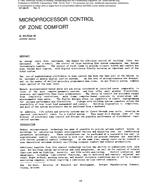Description
As energy costs have increased, the demand for efficient control of building loads has increased. As a result, the control of large building HVAC system components has become increasingly complex. The control of local loads to provide occupant health and comfort has also become more complex, with digital electronics finally becoming an important part of the total system.
The use of sophisticated electronics in zone control has been the last part of the system to be included in modern digital control systems. As the cost of microprocessors has dropped, and as the number of skilled microchip programmers has risen, we are finally seeing complex logic applied at the zone level.
Modern microprocessor-based units are now being introduced at installed costs comparable to those of the more complex pneumatic systems, and they offer much greater flexibility, accuracy, and capability than their predecessors. The choice of control now available ranges from completely centralized, main frame computer-based controls to stand-alone submicrocomputer zone units. The digital designs allow the capability of remote reprogramming for optimum performance and flexibility. Linkage with building system computers allows the possibility of true local load management and control. Building diagnostics is simplified, and much of the system maintenance may be performed from a keyboard.
In addition, life safety and security systems may be linked through zone units, creating an improved cost-benefit ratio for a digital system. This paper will discuss some of the history of electronic zone control and discuss the possible performance of distributed logic control systems.
Units: Dual
Citation: Symposium, ASHRAE Transactions, 1986, vol. 92, pt. 1B, San Francisco
Product Details
- Published:
- 1986
- Number of Pages:
- 11
- File Size:
- 1 file , 1.1 MB
- Product Code(s):
- D-SF-86-11-3




